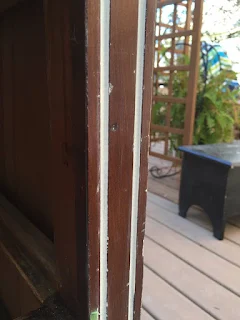Vintage Dresser Gets a Second Chance
This dresser literally didn't have a leg to stand on! I spotted it at a thrift store and initially passed it by because it was priced so high at $200. Seriously? I went back a few weeks later and there was a drastic price reduction to $30. At that price it was worth a gamble to see if I could save it!
Before
This piece is from the early 1900's and one of my favorite styles. There was some damage to the veneer and wear and tear throughout. And as you can see in the photo below, the legs of the dresser were missing.
 |
| Before: missing legs. |
The first step was to add some legs. I found some at Lowe's that I thought would work with the style of the dresser. But it did require some nut sleeves to be added in order to attach the legs. That took some trial and error to get it so the legs were sturdy enough to hold the weight of the dresser.
 |
Long story short, my husband had to drill a hole to counter sink the sleeves and then added 4 screws to add even more stability to the sleeve.
Next I added some wood glue to the legs, screwed them in, and then let the weight of the dresser sit on the legs while the glue dried. It's solid as a rock now.
Painting Details
My design plan at this point was to paint the base of the dresser in blue with white in the grooved areas. But painting details can be time consuming. So here's what I did to speed things up:
First I painted two quick coats of Old White into the grooves. I didn't worry about being overly precise. Then I took a damp washcloth and wiped away the excess paint. Easy-peasy.
I repeated the same process on the drawers.
And now for the big reveal of my secret weapon for the project -- Sculpey clay! Since the clay doesn't dry out until it's baked I was hoping it would work for this project. After the paint was dry, I pressed the clay into the grooves and then used my fingers to wipe off any extra clay.
Next I painted Duck Egg Blue chalk paint over the entire base of the dresser and the drawers. After the paint was dry I used a Q-tip to remove the clay. The grooves in the drawers were too narrow for a Q-tip, so I used a wood skewer to remove the clay on that area. It's important to use clay that matches the color of your paint just in case any residual remains behind.
The Top
I sanded the top and my plan was to re-stain it. The wood was beautiful underneath, but the two lighter striped areas were distracting to me, so in the end I decided to paint the top. But it was worth sanding it to remove all the scratches.
After
I painted the top in Old White and Coco and then sanded it back to a translucent finish. I distressed the remainder of the dresser and then sealed it with clear wax.
I painted the knobs in Old White and dry brushed Coco over it to coordinate with the top.
I also painted the trim in white.
The dresser is now functional again, and if I do say so myself, beautiful, too!
Thanks for stopping by!




















Comments
Post a Comment
Select the NOTIFY ME box to receive a notification of a reply to your comment (yes, I do try to acknowledge all comments). There might be a publishing delay on older posts as they are moderated to reduce spam.